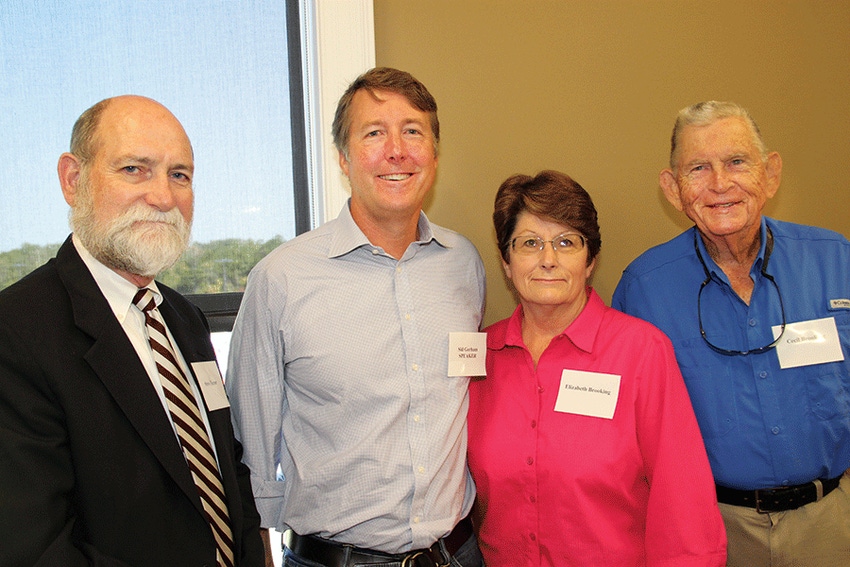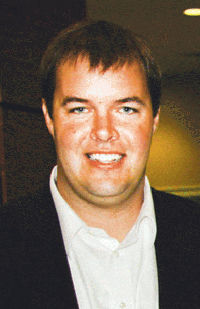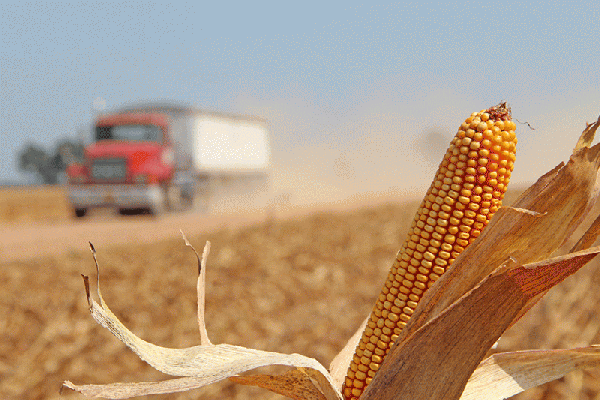

JEREMY JACK
Changes in technology and management have brought “dramatic changes” in agriculture, says Belzoni, Miss., farmer Jeremy Jack — and software designed specifically for technology-oriented farming operations can help producers to better achieve their goals.
In the nine years since earning his master’s degree from Mississippi State University, he said at the annual meeting of the Mississippi Agricultural Economics Association, his family’s farming operation, Silent Shade Planting Company, has gone from less than 3,000 acres — “my father, my mother, myself, and two employees, plus truck drivers” — to it’s present-day 12,000 acres-plus, a 30-person staff, and nine trucks.
“Agriculture faces a tremendous task in feeding a growing world, with fewer people on farms and fewer acres in production each year,” says Jack. “We’re challenged to produce more with less — and two important components in doing this will increasingly be technology and management. We’re using a lot of technology and related management techniques to make our farm more productive, to grow the operation and make it sustainable for future generations, and to do what we can to help our neighbors and other farmers in the area to succeed.”
After his sister learned about new farm management software at a peer group meeting last year — “She texted me that everyone at her meeting was talking about Granular software” — Jack says they later met Sid Gorham, Granular CEO, in Chicago.
“The direction in which they were going, and the ideas they had, were completely different from anything else we’d dealt with in software for agriculture; it was amazing what they were doing, the concepts they were bringing into the agriculture world. We began working with them to provide data and input on management specific to southern crops production.
“Our entire crew is using the software this season. Right now, I can look at my iPhone and see where my entire crew is, who’s doing what, what’s been accomplished today, what’s next on the list of things to do. It’s a really great day-to-day management tool — and at the end of the year I’ll have a record of everything that everyone on the farm has done.”
Stay informed on what’s happening in Mid-South agriculture: Subscribe to Delta Farm Press Daily.
Jack, who is serving as president of the Mississippi Agricultural Economics Association, had invited Granular’s Sid Gorham to attend the meeting and discuss the evolution of the software.
Growth-oriented farmers
It is, Gorham says, aimed at “professional growers who are growth-oriented and are trying to push the management of their farms forward as rapidly as possible.” Sometimes, he says, that correlates to farm size, but not always. “We work with 30,000 acre farmers, but also 2,000 acre to 3,000 acre growers who want to be the best farmers they can be.” It is being used in 30 states and Canada, with an average farm size of 10,000 acres.

"With software, you can look on your phone and see where every person on the team is. You don’t need to be on the radio constantly checking on people. Everyone on the farm team always knows what everyone else is doing.â€â€”Sid Gorham
Granular, based in San Francisco, is backed by Google and other venture capital investors, Gorham says. “Our expertise is in software and analytics, but we work with advisors and customers like Jeremy who share their farming experience and knowledge to help us make our software as useful as possible. Jeremy is among a group of really smart farmers who’ve helped our developers build a product that can help farmers more effectively manage their operations.”
One of the most important things software can do is foster collaboration and communication, Gorham says. “Many farms today are run by two-way radio — a lot of radio traffic all day long, everyone checking in with each other, and nobody quite has the whole picture of what’s happening. With our software, you can look on your phone and see where every person on the team is; you don’t need to be on the radio constantly checking on people. Everyone on the farm team always knows what everyone else is doing.”
Process control is another significant benefit, he says — why things are done in a certain way, “things farmers know, but have never written down,” along with measurements and improvements. “It’s critical to be able to understand how long it takes you to do things, what the quality is, what the cost is — basic professional business management.” And software can facilitate decision-making and data analysis, Gorham says.
While some contend that farming doesn’t lend itself to computers and software, he says, farming isn’t that different from other complex businesses, such as construction, shipping, police, or sports, “where all sorts of people are coming onto a job site, doing different types of work, needing different kinds of information, all utilizing software every day, all day, for analysis and decision-making.
“Are farms more complex than the Port of New Orleans or the police force in Manhattan? Probably not. Farming is challenging and complicated, things are constantly changing, much of it is intuition-based, an art not a science. A lot of people say you can’t codify that.
Tech-savvy workers
“We’re also told that the farm labor force just isn’t tech savvy enough. If they’re not tech savvy enough to use Granular, maybe you don’t want them driving your $400,000 piece of machinery or applying expensive inputs. If they’re not willing or able to be the kind of person who wants to learn new things, maybe they shouldn’t be part of the farming operation.”

"Desktop software just doesn’t work for today’s farms — it needs to be really, really easy to use, and it needs to be available everywhere."—Getty Images/Justin Sullivan
The “Cloud,” where data are stored and accessed via the Internet, and mobile devices such as smart phones and tablets have made software like Granular feasible, Gorham says. “
“Our first goal was to develop software that makes it easier to run the farm and save time. Farmers aren’t going spend a lot time sitting in the office trying to learn software. They need software that keeps things running on time and allows them to do more work every day, freeing up time to be more thoughtful and analytical about their business.
Important upcoming events: Delta Farm Press Calendar of Events
“We give them analytical tools to help make better decisions. We don’t believe there’s one big algorithm in the sky that’s going to decide for the farmer when to apply nitrogen, rent a new field, or what crop to grow. We don’t imagine that computers are going run farms — at least not for a really, really long time. But we do believe computers and software can help farmers make better decisions and make it easier to run a farm.
Check current commodity prices
“We look at this as two buckets: field and office,” Gorham says. “In the field, everyone has Granular running on their mobile device, and they can view the plan for each field, or crop, or the whole farm. They can see one big to-do list for the farm, field, or crop. It’s really important that they’re able to understand the general plan. Once everyone understands the work that needs to be done, they can figure the optimum way to do it.”
Two types of farms
Farms often fall into two categories, Gorham says. “Some are very decentralized in their decision-making. The farm crew have been working together for a long time, they get together in morning and figure out what they’re going to do first, then dynamically prioritize what they’re going to do through the day.
“Others are more top-down, where there’s clearly a quarterback who says, ‘Now you do this, then you do that,’ somebody dispatching the team. Our software supports both management styles, and everything in between. Importantly, it provides constant status and location of the team, and shows progress against work that needs to be done: What did we get done today, how far along are we, what do we need to do tomorrow?”
Farming the Arkansas Delta: Photos by Brittney Turner
In the farm office, Gorham says, “We’re replacing Excel [widely-used spreadsheet software]. Excel is a wonderful program, but it can get pretty complicated to maintain a complete picture of a 10,000 acre farm. With our software, you enter data once and it’s everywhere you will ever possibly need it. If you look at Field 7, you know it’s rented from this landlord, here are the rental/lease terms, here are the field boundaries — these data are organized and always available.
“We often hear complaints by folks in the farm office that they don’t know what’s going on in the field, which impacts what they need to do. With Granular, the folks in the office always know what’s going on, what’s been done, and they’re able to manage things as they need to. Field and office are continuously in synch to support better decisions.
“Our focus is more on the business of farming — less on what it takes to get you to 220 bushel corn than on what it takes to get you to X percent profit margin on your corn, more on dollar yield than bushels yield.”
Determining unit economics
The goal, Gorham says, is to help farmers determine the unit economics of their business: How profitable is this field? How profitable is corn as opposed to cotton or soybeans? How profitable is a given rotation? How profitable is it to rent at this price? What if this happens? How should I hedge this? What if the price of a field goes up 30 percent? What does my business look like if the world looks like this? Farmers have all sorts of exposure: weather, markets, input costs, and on and on. They need to be able to turn some knobs and make more intelligent decisions, rapidly and with confidence.
“If someone says, ‘Do you want to rent this land at this price?’ and you’ve got to go home and spend your weekend fiddling with Excel to come up with an answer, you may miss that opportunity.”
The software also enables farmers to connect with peers and those who are key to their operation: landlords, bankers, crop insurance providers, suppliers. “You could send them Excel worksheets, which might be full of errors or out of date, or you can say, I’m going to be successful by distinguishing myself by allowing these key people to log into my Granular account and obtain the information they need about my crop marketing, or risk management, or other data that might convince my banker to give me a better operating loan, or convince a landlord that I should be the tenant of choice. All this is key to my growth.”
Information sharing is permission based, Gorham says. “You can control the information you want them to see, while everything else is protected. We think there’s a real opportunity for professional producers to connect with their peers and to their suppliers and customers. But,” he emphasizes, “the farmer owns the data. Nothing can be shared or accessed without their permission.”
Many companies trying to bring software to farms, he says, “are actually trying to sell something else to the farmer — seed, equipment, other products or services — rather than saying, as we do, my only business is software, and I’m not trying to lock you into some other business relationship.”
Today’s progressive, ambitious farmers are expansion-oriented, Gorham says. “Almost all of them are trying to get bigger. They’re asking questions such as, Am I profitable enough to expand? With what acres, at what price? Am I prepared to grow? How will that change my operation? Business is all about making the right decisions, with confidence, fast.”
About the Author(s)
You May Also Like




